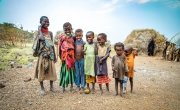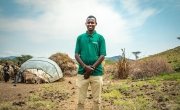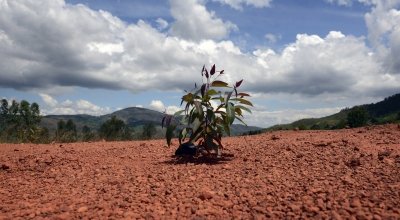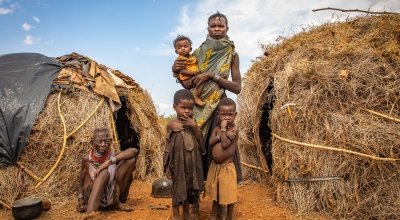
Knowledge Hub
For years, global warming and climate change have been causing extreme and erratic weather patterns, such as heat waves and droughts, resulting in what we now know as the climate crisis. Whilst almost all of us experience this erratic weather in some way, it tends to hit the poorest and most vulnerable people the hardest.
For years, global warming and climate change have been causing extreme and erratic weather patterns, such as heat waves and droughts, resulting in what we now know as the climate crisis. Whilst almost all of us experience this erratic weather in some way, it tends to hit the poorest and most vulnerable people the hardest. So what exactly is erratic weather, and why is it so dangerous for people living in the world’s poorest places?
What is erratic weather?
Erratic weather means weather that is strange for the season and that it changes a lot from day to day. The severity of erratic weather can vary from the weather simply being warm one day and cold the next, to more dangerous cases of heat waves and drought. Today, approximately 400 extreme weather events take place across the planet in any calendar year; four times the number experienced in the 1970s. These changes in extreme weather relate to climate change, and they pose a significant threat to people who live in already fragile contexts, or who rely on agriculture to survive.
Heat waves
Heat waves are periods of abnormally hot weather lasting days to weeks, and the number of heat waves is increasingly on the rise. The impact of heat waves vary in severity. For some, heat waves simply mean more uncomfortable train journeys and higher AC bills. For others, they pose a significant health risk.
The combination of high heat and vulnerability can be deadly. Vulnerable people include the elderly, infants and children, pregnant women, outdoor and manual workers, athletes, and people living in poverty. Europe's severe heatwave killed 70,000 in 2003; indicating developed nations are home to vulnerable people when temperatures rise. In lower income countries, the numbers are much higher due to increased exposure to higher temperatures, cramped living conditions with little to no ventilation and limited access to water.

Rapid rises in heat compromises the body’s ability to regulate temperature – also known as heat stress – and can result in a myriad of illnesses, including heat cramps, heat exhaustion, heatstroke, and hyperthermia. The World Health Organisation [WHO] has said heat stress, linked to climate change, is likely to cause 38,000 additional deaths a year worldwide between 2030 and 2050.
Droughts
Extreme heat can increase the risk of natural disasters, including drought. However, defining a drought can be tricky. A general definition of a drought is ‘a prolonged period of abnormally low rainfall, leading to a shortage of water’ [Oxford Dictionary]. They can happen over a long period and can be devastating to both the economy and human life.
Climate change will undoubtedly increase the frequency, duration and severity of droughts in many parts of the world. Droughts can lead to a number of potentially devastating issues including large-scale crop failure, livestock deaths, rising costs of food, as well as restricting people’s access to clean water, good sanitation and healthcare. During a drought, there is so little rain that an entire region can start to dry out. When little or no rain occurs, plants and crops can die because the soil is too dry for them to grow.

Droughts also may lead to a faster rate of land degradation and desertification, which, in turn, is likely to increase poverty. Desertification is the process by which fertile land turns to desert, reducing its natural potential to grow, and having hugely negative repercussions for those who rely on it to survive.
According to the UN, one billion people across 100 different countries face the threat of desertification, and that figure is only going to get bigger as the planet heats up.
Flooding

According to the WHO, floods are the most frequent type of natural disaster and occur when an overflow of water submerges usually dry land. Heavy rainfall, rapid snowmelt, cyclones or tsunami’s are the most common causes of floods.
Floods can cause widespread devastation, resulting in loss of life, damage to personal property and serious public health risks. Between 1998 and 2017, floods affected more than 2 billion people worldwide. Heavy rainfall and floods are also increasing in frequency and intensity due to climate change, and are expected to continue to do so.
Why is erratic weather so dangerous for the world’s poorest people?
As detailed above, erratic weather, exacerbated by climate change, has huge environmental and socio-economic impacts. It is often the world’s poorest people – and the people who have had the least to do with damaging the planet – that are most affected. According to the World Bank, at 2°C of warming, between 100 million and 400 million more people will be at risk of hunger. A staggering one to two billion people will no longer have adequate access to clean water.
Impact on nutrition
Climate change, agriculture and nutrition are interconnected. Increases in temperatures and droughts will result in decreasing crop yields and increasing livestock deaths. The increased frequency of extreme weather disasters which we are already experiencing can also contribute to rising food prices and jeopardise peoples’ access to food. Overall, climate change will worsen food insecurity and restrict access to the diverse diets that humans need to survive and thrive.



The region of Turkana in northern Kenya is one example and on a recent visit by Concern, the consequences of the climate crisis were clear to see. An area the size of Ireland, Turkana used to experience droughts every 15 to 20 years. However, from the late 1990s onwards, that reduced to every five years. More recently? People are experiencing drought every second year.
Agriculture and locusts
In May and October 2018, two devastating cyclones hit East Africa. The heavy rainfall that followed provided the moist conditions desert locusts require to breed. Warmer seas caused by climate change could lead to more cyclones, which in turn could lead to an increase in species of locusts such as this.
The current infestation marks the worst in decades. Currently, huge swarms are devastating crops in Somalia, Ethiopia and Kenya, putting the lives and livelihoods of millions at risk, and it will only get worse with climate change. The warming planet will see larger swarms of hungrier insects eat their way through millions more tons of rice, maize, and wheat crops globally by 2050. For every one degree rise in average temperatures, insects will eat an extra 2.5% of the world's crops, which most of the world relies on to survive. This will be devastating for people living in the world’s poorest places.
Impact on displacement
Compounding the threat posed by the changing climate is the refugee crisis. The two are closely linked, with extreme weather events often a factor in social, political and economic instability. Since 2008, an average of 21.7 million people have been displaced each year by extreme weather-related disasters – the equivalent of 41 people every minute. This does not include the people forced to flee their homes as a consequence of slow-onset environmental degradation, such as droughts. Over the next decade, climate change will force millions of people from their home, creating the biggest refugee crisis the world has seen.
Other ways to help
Donate now
Give a one-off, or a monthly, donation today.
Join an event
From mountain trekking to marathon running, join us for one of our many exciting outdoor events!
Buy a gift
With an extensive range of alternative gifts, we have something to suit everybody.
Leave a gift in your will
Leave the world a better place with a life-changing legacy.
Become a corporate supporter
We partner with a range of organisations that share our passion and the results have been fantastic.
Create your own fundraising event
Raise money for Concern by organising your own charity fundraising event.





